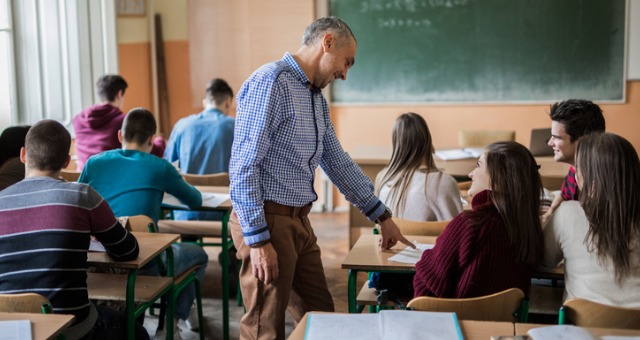Unlock Your Child’s Potential with Primary Science Tuition Singapore
Unlock Your Child’s Potential with Primary Science Tuition Singapore
Blog Article
A Comprehensive Guide to the Different Discovering Techniques in Primary Science Direction
The expedition of diverse knowing approaches in main scientific research guideline provides an opportunity for instructors to improve trainee engagement and comprehension significantly. By analyzing hands-on knowing techniques, inquiry-based techniques, and collective approaches, we can identify efficient methods that provide to numerous learning designs.

Hands-On Knowing Techniques
Hands-on knowing strategies play an essential role in main science direction, involving trainees in energetic exploration and testing. These techniques enable students to communicate straight with phenomena and products, fostering a deeper understanding of scientific ideas. By making use of manipulatives, designs, and real-life experiments, instructors develop an atmosphere where pupils can observe, hypothesize, and examine their ideas.
Such methods not only improve understanding yet additionally cultivate critical reasoning and analytical skills. When trainees take part in activities like developing straightforward makers, planting seeds, or performing chain reactions, they are motivated to ask concerns and look for solutions via their very own observations. This experiential approach assists to demystify complex scientific concepts, making them more available and relatable.
Furthermore, hands-on discovering promotes partnership amongst peers, as pupils often operate in teams to conduct experiments or share findings. This teamwork not just enhances their knowing experience yet also develops essential social abilities. Inevitably, incorporating hands-on strategies in key scientific research guideline promotes a long-lasting love of learning and curiosity about the environment, laying a strong foundation for future scholastic searches in science and beyond.
Inquiry-Based Learning
Inquiry-based discovering is an instructional method that urges students to ask inquiries, explore sensations, and construct their own understanding of scientific concepts. This approach changes the focus from standard teacher-led guideline to an extra student-centered experience, where students take the campaign in their instructional journey. By fostering inquisitiveness, inquiry-based knowing advertises deeper interaction with the material, permitting students to discover subjects in a meaningful context.
In method, this strategy commonly entails hands-on experiments, observations, and vital reasoning activities that align very closely with the clinical approach. Students are motivated to formulate theories, design examinations, and analyze information, which cultivates necessary abilities such as analytical and logical thinking. The function of the instructor in this framework is to assist in expedition, directing trainees through the query procedure while urging independent thought and collaboration.
Moreover, inquiry-based discovering supports a sense of ownership over the discovering procedure, encouraging trainees to seek expertise proactively. This method not just enhances understanding of clinical ideas but additionally fosters a long-lasting love for knowing, outfitting trainees with the skills essential to navigate a progressively intricate world.
Collaborative Understanding Approaches
Collaborative knowing strategies encourage students to take part in purposeful communications with peers, promoting a shared responsibility for their academic results. In main science direction, these approaches motivate students to interact to discover clinical ideas, address issues, and conduct experiments (primary science tuition Singapore). By taking part in team tasks, students can take advantage of varied point of views, permitting for richer understanding and retention of scientific expertise
One secret facet of collective understanding is the focus on communication abilities. Students need to articulate their thoughts, pay attention actively to others, and negotiate concepts, all of which are crucial competencies in both academic and real-world contexts. This social interaction not just improves their understanding of clinical concepts but also promotes team effort and conflict resolution skills.
In addition, joint learning typically causes increased motivation and engagement. They are more most likely to take possession of their knowing trip when pupils see the value of their contributions within a group. Teachers can facilitate this process by designing structured team jobs that line up with curriculum objectives while providing advice on reliable collaboration methods. Overall, integrating joint knowing approaches in main science direction cultivates a vibrant learning setting that prepares pupils for future academic and social difficulties.
Technology Assimilation in Scientific Research
The combination of modern technology in key scientific research direction boosts discovering experiences by offering ingenious devices and sources that sustain various mentor methodologies, including collaborative knowing - primary science tuition Singapore. Making use of electronic platforms, simulations, and interactive applications allows trainees to engage deeply with scientific ideas, facilitating a more hands-on technique to discovering
Virtual labs, as an example, allow learners to conduct experiments safely and effectively, promoting inquiry-based discovering. These tools can imitate real-world clinical circumstances, permitting students to envision complex processes Get More Info that would be hard to reproduce in a typical class setting. Furthermore, innovation cultivates interaction and cooperation amongst trainees, as they can share searchings for and function with each other on tasks with online systems.
Additionally, multimedia discussions and educational video clips can enrich lessons by dealing with diverse learning designs, making abstract concepts a lot more easily accessible. Data analysis tools go to this site additionally empower pupils to collect and analyze scientific information, reinforcing critical believing abilities. On the whole, the calculated incorporation of innovation in key scientific research guideline not only boosts engagement however additionally prepares students for a highly advanced society, outfitting them with important abilities for future clinical endeavors.
Separated Guideline Techniques
Set apart guideline techniques are necessary for dealing with the diverse requirements of students in main scientific research education and learning. These strategies enable instructors to customize their teaching techniques to fit differing capacities, passions, and finding out styles within the classroom. By employing separated direction, instructors can develop a comprehensive setting that cultivates involvement and boosts understanding of clinical principles.
One effective approach is to use adaptable grouping, which enables trainees to work together with peers at similar skill degrees or with varying point of views. This strategy urges peer understanding and advertises important reasoning. Furthermore, providing choices in assignments can encourage trainees, enabling them to pick tasks that resonate with their interests while still fulfilling curricular purposes.
Additionally, integrating tiered assignments is an additional useful technique. By designing jobs with differing levels of intricacy, teachers can guarantee that all students are suitably challenged, no matter their efficiency. Utilizing developmental analyses to assess understanding more allows teachers to readjust their training methods dynamically, making certain that each learner obtains the support they require.
Inevitably, carrying out differentiated direction techniques in key science education and learning not only improves student discovering outcomes however also cultivates an interest for science, preparing trainees for future scholastic quests.

Final Thought
In recap, effective key science direction demands a diverse strategy that encompasses hands-on discovering, inquiry-based methods, and collective strategies. The integration of innovation and set apart instruction additionally satisfies diverse discovering designs, fostering an atmosphere helpful to exploration and vital reasoning. By implementing these techniques, educators can improve pupil engagement and comprehension, ultimately nurturing a long-lasting interest for scientific research and questions. Such detailed techniques are vital for creating educated and interested future researchers.
The expedition of diverse knowing methods in key scientific research direction provides an opportunity for educators to boost pupil interaction and understanding dramatically.Hands-on understanding methods play a critical role in key science instruction, involving students in energetic exploration and experimentation.Inquiry-based understanding is a training strategy that urges trainees to ask questions, explore phenomena, and create their own understanding her explanation of scientific principles.Collective learning strategies equip pupils to engage in significant interactions with peers, promoting a shared duty for their educational end results. Overall, including collaborative understanding methods in key science guideline cultivates a vibrant knowing setting that prepares students for future academic and social obstacles.
Report this page